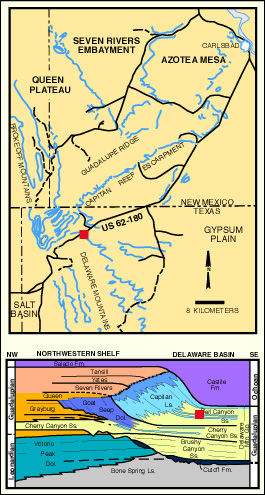
Permian Reef Complex Virtual Field Trip
Stop II-4: Rader Ls. Mbr., Bell Canyon Fm. – Basinal Slide Deposit

BE CAREFUL TRAFFIC IS ESPECIALLY HAZARDOUS AT THIS OUTCROP!

© Peter A. Scholle, 1999

© Peter A. Scholle, 1999
The section here shows a major submarine slide deposit at the base of the Rader Member of the Bell Canyon Formation. The southwestern end of the outcrop consists of laminated sandstones and siltstones of an unnamed member of the Bell Canyon Formation (see photo). At the top of this sandstone is a conglomerate zone with limestone blocks set in a sandstone matrix (see photo). The limestone clasts are very poorly sorted and range from pea-sized pebbles to car-sized boulders. The clasts are non-dolomitic, generally light-colored limestones derived mainly from the Capitan reef and upper fore-reef environments (Lawson, 1989). Above this zone of bouldery rubble is a thick, graded bed of similar, but finer grained, carbonate clasts with carbonate matrix and cement. This, in turn, is capped by a series of thin-bedded, fine grained, dark-colored limestones which are typical of the basinal limestone members of the Bell Canyon Formation.
This slide deposit is one of several which have been found in the Delaware basin. Three superimposed slides within the Rader Member make up the hummocky Rader Ridge in this area. Other slides are locally present in the Manzanita Member of the Cherry Canyon Formation and at the top of the Lamar Member of the Bell Canyon Formation (Newell et al., 1953, p. 69-77). These are, however, exceptional and localized events which move reef- and slope-derived material far beyond the range of the normal fore-reef rubble fans. For example, the outcrop we are at represents a slender, perhaps channelized, tongue of rubble which extends off a broader slide. This tongue of transported debris extends nearly 8 km (5 mi) into the basin from the reef crest. This deposit has been shown to thin rapidly from reef to basin (Newell et al., 1953). It is nearly 30 m (100 ft) thick at the base of the steep fore-reef slope but has thinned to less than 3 m (10 ft) at this locality.
The mechanism of transport of the limestone clasts probably is largely as a submarine slide or debris flow. The volume of material involved is comparable to that of large, documented, subaerial landslides (Newell et al., 1953, p. 77). As with subaerial landslides, there is relatively little disturbance of underlying soft sediment substrates. The incorporation of sandstone matrix with limestone boulders, and the channelized or abruptly terminated lateral margins of the slides indicate that there was some erosion and inclusion of the underlying Bell Canyon sandstone in the slide. But there may also have been some plowing, subsidence, or foundering of the large, heavy, limestone blocks into the underlying sands. The event which triggered the slide also, apparently, led to the generation of a turbidity current which deposited the thick graded bed which overlies the slide. This association appears to be a common one and has even been observed in modern submarine slides (Heezen and Drake, 1964, and numerous earlier papers by Heezen).
The Rader Limestone Member has a total thickness of about 4.5 m (15 ft) in this area, and about 3 m (10 ft) is exposed at this outcrop. The unit thickens to a maximum of about 36 m (120 ft) within about 5 km (3 mi) as one approaches the basin margin (to the northwest).


